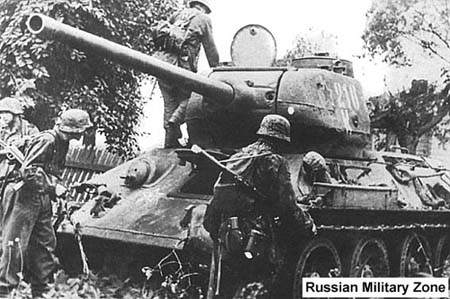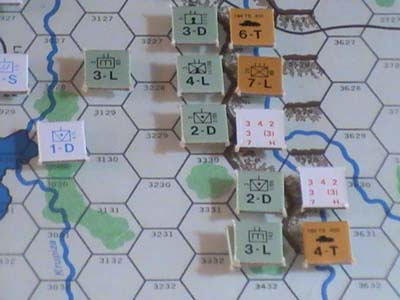WARGAMESOSD GDW White Death |
| Velikiye Luki - The Stalingrad of the North |
Game
Play and Mechanics |  |
wargames.wilkey.org.uk |
WARGAMESOSD GDW White Death |
| Velikiye Luki - The Stalingrad of the North |
Game
Play and Mechanics |  |
wargames.wilkey.org.uk |
| Sequence
of Play White Death is played in a series of game turns, each representing 5 days of real time. Each game turn will consist of a variable number of impulses, with the exact number in each turn determined by the decisions and actions of the players. Briefly, each player has ten movement points which he may expend each turn. The Soviet player always moves first, and thus takes the first impulse of the turn. The Soviet player decides how many movement points he will expend in his impulse (as few as one or as many as ten). After he finishes his impulse, the German player conducts an impulse with as many or as few movement points as he desires. This alternation of movement points continues until one side exhausts its supply of ten movement points for the turn. The other player then conducts one or more impulses consecutively until he also has exhausted his supply of ten movement points. This concludes one turn. During a Soviet impulse the Soviet player is referred to as the phasing player and the German player is referred to as the non-phasing player. During German impulses these roles are reversed. All action within an impulse is conducted in the following sequence of play: 1. Decision Phase: The phasing player decides how many of his remaining movement points will be spent in the current impulse and moves the "current" marker to reflect the expenditure of movement points. (The German current marker is labeled GC; the Russian current marker is labeled RC.) 2. Movement Phase: The phasing player moves all units desired and declares all attacks. Each unit may move up to the limits imposed by the Decision Phase. 3. Barrage Phase: The phasing player conducts all barrage attacks. 4. Defensive Fire Phase: The non-phasing player conducts all antitank and conventional defensive fires. 5. Assault Phase: The phasing player conducts all antitank and conventional fires by attacking units. 6. Terminal Phase: The phasing player moves the "initial" movement marker to the same box on the movement point track as that occupied by his" current" marker, to show how many movement points will be available at the beginning of the next impulse. The supply marker is moved on the supply track to show expenditure of supply, if any. All attack markers are removed from attacking units. After both sides have conducted all impulses for a turn the turn record marker is advanced one space on the turn record chart and a new turn is begun again with the Soviet impulse. Types of Impulses: There are two types of impulses: an action impulse and a pass. In an action impulse the phasing player expends one or more movement points and conducts movement and combat. In a pass impulse the phasing player expends only one movement point and may conduct no actions at all except for barrage attacks and rail movement. The Soviet player when conducting an action impulse must expend at least three more movement points or all remaining movement points, if he has less than three. |
Unit
Identification |
 |
| Sample
of Play |
 |
The above sample, from Turn 1, shows the Soviet player attacking the Axis player's artillary units. Note that to conduct battle the reverse side of the counters are required to calculate the strength and mechanics of the attack. This is a 'barrage' attack with Soviet artillary, barrage factors are '2' as indicated by the numbers in the top right corners of the attacking units. Barrage fire can have mixed results and in the final analysis it is my view that barrage fire should only be used with heavy artillary such as rocket launchers or heavy mortar to get the desired results. |
| GDW Designer's Notes |
| The
Battle: The introduction to the rules and the historical commentary for each
scenario cover most of the important points of the battle around Velikiye Luki
in the winter of 1942/43, but a couple additional points deserve mention. Velikiye
Luki has not received as much attention as might be expected as it has largely
been overshadowed by the battles around Stalingrad and Rzhev taking place at the
same time. Nevertheless, Velikiye Luki was important both in its own right and
in the context of the other two battles. Velikiye Luki is a small battle only by comparison to the truly massive battles of Rzhev and Stalingrad. The Red Army committed thirteen divisions and sixteen major brigades to the action and the Germans responded with eight complete (or nearly so) divisions and the manpower equivalent of at least four more divisions in non-divisional units. The battle is important also in that it serves as an interesting disproof of what has come to be the conventional wisdom on the middle period of the fighting on the Eastern Front. It has often been held that in this period the Soviets succeeded offensively only when several factors were in their favor; generally, careful planning and overwhelming numbers are considered pre-requisites. At Velikiye Luki, however, Purkayev's 3rd Shock Army was fighting under far-from-ideal conditions. While outnumbering the German troops committed, the Soviet superiority was hardly overwhelming considering the objectives of the assault. Counting all troops committed to action throughout the battle, Purkayev held a bare 1.5:1 superiority over Woehler's force in both infantry and and guns of 75mm and above (although this does include German security units, construction battalions, etc. in the proportion, as these units were thrown into the fighting). Only in armor did Purkayev hold a 3:1 edge, with about 500 Soviet tanks facing around 160 German AFVs of all types. While failing in its ultimate goal of cutting the Nevel-Leningrad railroad, 3rd Shock Army nevertheless managed to inflict a clear tactical reverse on the German forces in the Velikiye Luki area. One measure of the German reverse is the scale of casualties suffered: Gruppe Woehler had been bled white by the end of the action. While admitting this fact in general terms, post-war German sources have nethertheless tended to play down the magnitude of German losses. The joint U.S.-German collaboration after the war, entitled Operations of Encircled Forces, claims that 5,000 troops were lost in Velikiye Luki itself, while Carrell's Scorched Earth admits to 7,500. In fact, examination of the initial strength of the garrison, combined with the fact that fewer than 500 German troops escaped the encirclement, yields a loss figure of between 9,000 to 10,000 men as a minimum. Adding the 12,000 casualties that Operations of Encircled Forces attributes to the relief force yields a minimum German casualty figure of 22,000 men, and this does not include losses suffered by German units in the area but not in the relief attempt (3rd Mountain Division, for example, which took a severe beating). A final consideration is the effect Velikiye Luki had on the other operations taking place simultaneously. It is difficult to tell what effect, if any, it had on the Rzhev salient offensive; since that Soviet offensive was a costly failure, there has been little specualtion as to what effect additional German troops would have had. If anything, Velikiye Luki may have had a more important effect on the Stalingrad fighting, even though that was much further away. Two good divisions, the 20th Motorized and the 291st Infantry, had already been alerted for transfer to Army Group South when it proved necessary to commit them to the Velikiye Luki area instead |